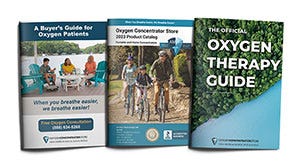-
![Respironics SimplyGo - Most Versatile Concentrator]() Respironics SimplyGo Portable Concentrator
Respironics SimplyGo Portable Concentrator- Pulse Dose & Continuous Flow
- 10 Pounds
- 3 Hour Battery Life
- Includes the SimplyGo unit, battery, AC power supply, AC cable, DC charger, bag and cart.
-
![Recertified Pre-Owned Respironics SimplyGo]() Recertified Pre-Owned Respironics SimplyGo
Recertified Pre-Owned Respironics SimplyGo- Pulse Dose and Continuous Flow
- 10 pounds
- Certified Used Unit
- 30 Point Inspection
Your Price $1,500.00 List Price $2,295.00
Featured Videos
Getting Started with Portable Oxygen Concentrators Video
Top-Rated Portable Concentrators of 2022
Learn More About Portable Oxygen Concentrators
Why Choose Oxygen Concentrator Store and AMSR?
Here at American Medical Sales and Rentals we know that once you’ve been prescribed oxygen therapy things can get a little overwhelming.
Read More on Why to Choose Oxygen Concentrator StoreIntroduction to Supplemental Oxygen
Respiratory diseases often create the need for more oxygen than what is available in the air. If you have COPD, you may already be using supplemental oxygen and if not you may have already discussed it with your doctor.
Read More on Supplemental OxygenGuide to Flying with an Oxygen Concentrator
In a continuing effort to educate oxygen users about traveling and flying with oxygen, we’ve created this guide to assist in planning your next flight. By planning well, you can ensure you that you can have an enjoyable and successful trip.
Read More Guide to Flying with OxygenFind the Correct Unit With Our Oxygen Therapy Survey
Discover the Unit that Best Fits Your Requirements, Lifestyle and Budget! Simply answer a few brief questions to assist us in learning what oxygen concentrator is best for you.
Take the Oxygen Concentrator SurveyA few revolutionary machines have been released over the past few years, and some older models have been updated with the new expectations that come along with the release of new oxygen technologies. The most recent technological advancements have brought the developments of some portable machines that are bringing a whole new concept of freedom to oxygen users. Of course, not every oxygen therapy product will be right for you. You’ll need to make sure the POC can meet all of your needs.













